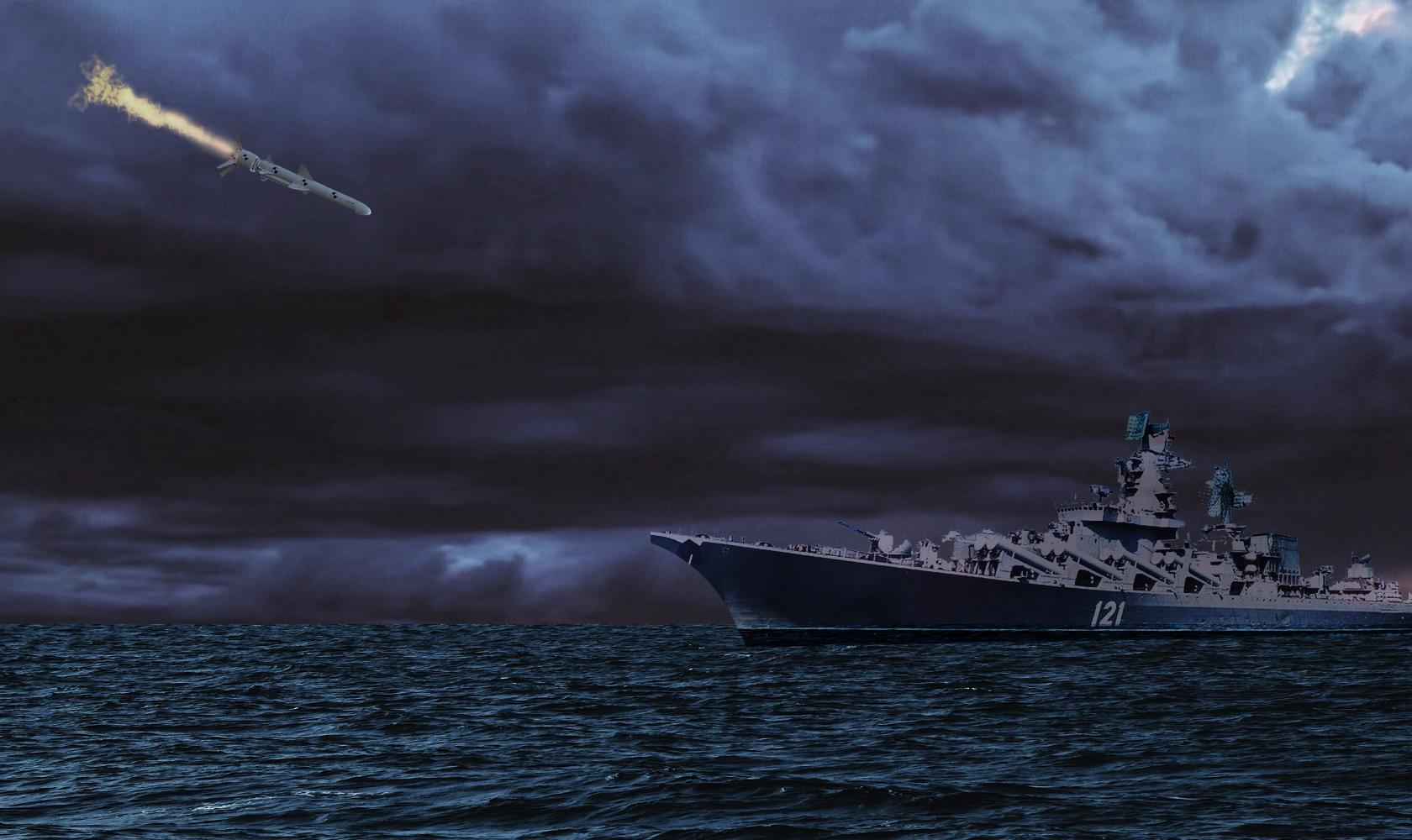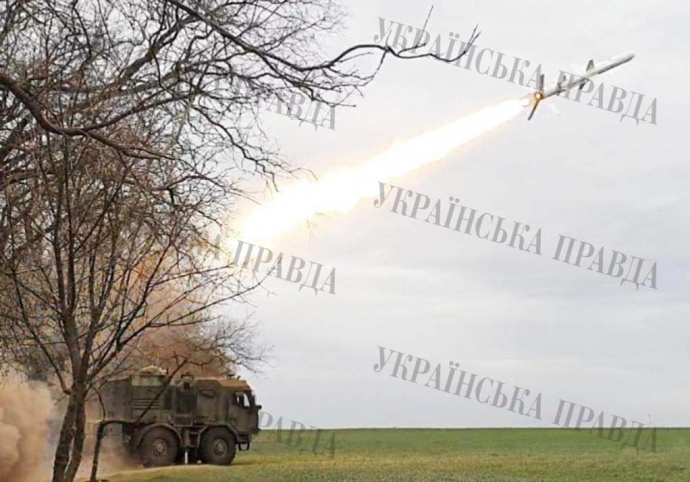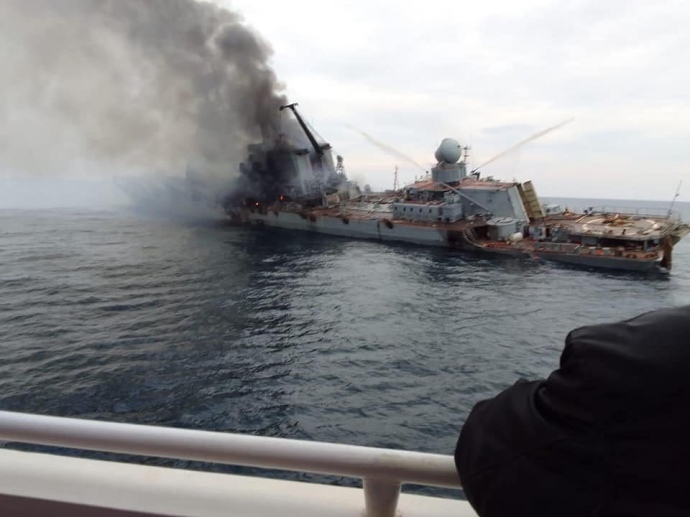Sinking the Moskva: previously undisclosed details. How the Ukrainian Neptune destroyed the flagship of the Russian fleet

13 April 2022 was, probably, the worst day to try to scupper the Moskva cruiser - the weather was foul.
From the very early morning, the sky above the Black Sea was covered by heavy clouds on the horizon. They hovered like a dense black blanket a couple of kilometres above the water, with nothing to be seen from the sky on the surface of the sea.
Nothing was of any use - not fighter jets, not Bayraktar TB-2 drones, not even optical satellites.
In these circumstances, only an over-the-horizon radar, the signal of which can go around the Earth, could have made a difference. But on 13 April the operator of the Neptune system had only basic radars at hand - these see targets no further than 18 kilometres.
All of this was known to the crew of the Moskva cruiser, who were thinking that they were in complete safety.
"They understood that they could not be seen from the sky or shore. In addition, they had very serious air defence and other security systems on board. This is why they positioned themselves as close as 120 kilometres from the Ukrainian shore. And this overconfidence was what ultimately ruined them", one of the Ukrainian rocket experts involved in the Neptune project said off the record.
It was nature herself that helped Ukraine on the day of 13 April. The Neptune operator shouldn’t have reached the Moskva with a basic radar, but this was what actually happened. So after several minutes of pondering and consultations he ordered the launch and two missiles took off in the direction of the cruiser with a small time interval in between.
Their approximate time of reaching the target was a bit more than six minutes. What would happen after, no one knew.
Ukrainska Pravda has conducted dozens of interviews with people from the Ukrainian military, invested a couple of weeks, retrieved a photo of the historical launch and now offers the readers the first reconstruction of how the Ukrainian Neptune scuppered the Moskva cruiser.

Neptune’s baptism of fire
Almost no one knows about it, but the first combat use of the Neptunes took place not in April but in the first days of the full-scale invasion by Russia. It was then that three Russian landing ships left the ports in Crimea and headed towards the Ukrainian coast in Mykolaiv Oblast. The landing of Russian troops in this area gave them a springboard to attack both Mykolaiv and Odesa.
The first three Neptune missiles were launched to destroy these ships.
"The first launches were from the south of Odesa Oblast, fired in the direction of Mykolaiv. Because of that the missiles had to go over Odesa, and, for the sake of safety of the city, they were fired not 5-6 metres above water, as it had to be done, but over 120 metres. Obviously, the Russians spotted and most likely destroyed them. It is interesting that they even shot down their own aircraft that was hunting for Neptunes in that sector" according to Ukrainska Pravda’s source from military circles involved in the Neptune project.
Ukrainska Pravda could not establish exactly when Neptune’s baptism of fire took place, but it certainly happened no later than 26 February. On that day, the General Staff issued an official report that a Russian warship had shot down its own aircraft over the Black Sea.
None of the Neptunes reached their targets that day, but, as Ukrainska Pravda’s sources suggest, the Russian ships, frightened by the very possibility of such missile strikes, turned around and quickly sailed back to Crimea.
The "surprise" of the Russians is understandable because the Neptunes were not supposed to be in service with the Armed Forces at the end of February.
After successful state tests in 2020, Neptune was added to the arsenal of the Armed Forces, but in reality the project was frozen. It was only at the end of that year, in particular after a meeting of the Head of the Luch Design Bureau Oleh Korostelyov and Volodymyr Zelenskyy, that money for the project was found at the special request of the President.
The first fully-fledged Neptune system on the new chassis from Tatra was assembled in August 2021, before the parade for the 30th anniversary of Independence Day.
The whole system was demonstrated at the parade: a mobile checkpoint, a universal self-propelled launcher, transport-charging vehicles and tractor units.
Nevertheless, months have passed between the parade and the admission of the Neptune system to the arsenal of the Armed Forces. In December 2021, Oleksii Neizhpapa, Commander of the Naval Forces of the Armed Forces of Ukraine, announced on a television programme that the first division of Neptunes will be supplied only in the spring of 2022.
"In spring the Neptune will be ready and incorporated into the Ukrainian Navy. Some of the equipment has already been bought, in spring we will have a full division set of Neptunes ready," said the commander of the Naval Forces.
But in December not even the missiles were ready. According to Ukrainska Pravda’s data, the first missiles, ordered for the army by the state, left towards Odesa only in the days following 20 February 2022. Literally days before the full-scale invasion, they were transported out of the factory in Kyiv, which has been bombed three times by Russia since then.
Fortunately, they were transported in time, and it was those missiles that saved Mykolaiv from the said Russian ships.

Blinding Neptune
The first use of Neptune missiles left the military with ambiguous feelings. The crews operating the systems had gone through training, conducted by the manufacturer of the missiles, and after the first launches in February the servicemen were in a real quandary. Something was wrong.
"The most disappointing thing for an operator is when their missiles just disappear and don’t hit their targets. That is why, after the first launches, sometime in March, the operator in charge of the system had developed some kind of paranoia. He ordered that all the missiles be checked, every nook and cranny", says one of Ukrainska Pravda’s military sources who witnessed the situation.
A group of specialists came from the Luch Kyiv Design Bureau, the main developer of the missile, to perform an inspection, and they discovered a very suspicious pattern.
"Specialists came from Kyiv and their jaws just dropped. They discovered that all the missiles had a faulty element, and because of that none of them detonated the way they should have. They repaired them, and then when the next launch of two missiles happened - bullseye", reports Ukrainska Pravda’s military source involved in the Neptune project.
All this looked exactly like a planned sabotage. However, Ukrainska Pravda’s sources in the Luch Kyiv Design Bureau are not inclined to consider the version implying intentional sabotage.
"We are always getting called to fix or check something. These are the specifics of a product. A missile is filled with sensitive electronics, there are a lot of hazards even at the stage of simply transporting it. I don’t believe there has been any sabotage," Ukrainska Pravda's source at the company developing the missile stated.
Nevertheless, two other sources within the military leadership, who are independent of each other, are assuming that the missiles might have been damaged intentionally.
"There was such a story, in fact. It turned out that all missiles had the same failure, and it was clearly made intentionally. This was the only time during the entire war [full-scale invasion - ed.] when I could have said that it looked like treason. But everything was fixed, and the Moskva is not around anymore," our source from intelligence confessed.

Find and sink: collapse of the Moskva
An operator of the Neptune coastal defence missile system with an expressive but currently classified Ukrainian surname received very unexpected data on radar at approximately 16:00 on 13 April 2022.
His usual radar showed that there was a big target some 120 kilometres from the shore. There could be only one thing of such a size in this sector of the Black Sea - the Moskva, the flagship of the Black Sea Fleet of the Russian Federation.
But how could a regular radar show an over-the-horizon target at such a distance? As Ukrainian missile operators assure off the record, weather itself took the side of the defenders.
Because of thick clouds hovering over the sea, the radar signal bounced off it to the water surface and vice versa.
"We did not have over-the-horizon radar at the moment of the invasion, and Russia knew this. But as the clouds were hanging very low, and the signal had nowhere to go from this corridor between the water and the clouds, the radar unexpectedly reached the Moskva," Ukrainska Pravda’s source explained.
The Russians were so confident of the fact that they were out of reach for Ukrainian forces that they probably had not even activated air defence systems, as our sources assumed. However, even if they had, they would have had big troubles with the Neptune missiles.
"The Neptune is a subsonic missile that runs on liquid fuel and sneaks up on a ship unnoticed until the very last moment. Until it is already too late. Conventional air defence systems are not capable of detecting it, because it flies above the water level," one of Ukrainska Pravda’s sources from members of the National Security and Defence Council of Ukraine explained.
Western media outlets have their own version of the events that occurred.
According to The New Yorker, Ukraine sent a request to NATO’s European centre to confirm the coordinates of the target and received it. The New York Times stated that a P-8 Poseidon reconnaissance aircraft was involved in performing Ukraine’s request. It was this aircraft that provided the exact coordinates. The specialist publication Navy Recognition stated the same thing.
However, people within Ukrainian military circles are sceptical about excessive exaggeration of the allies’ part in this.
"All these stories about how ‘big bosses’ are helping us are just playing into Russia’s hands. In fact, we are capable of solving tasks of unimaginable complexity ourselves. Well, do you really think that the Moskva flagship was hard to find? This is a 120-metre long mountain of iron and electronics in the small Black Sea. It can be detected by any satellites in any range. We have seen and detected it all this time," one of Ukrainska Pravda’s sources in the military leadership said indignantly.
"We obtain data from several dozen satellites, and now Prytula [Serhii Prytula - a Ukrainian volunteer who collected funds for Bayraktar UAVs and bought a satellite for Ukrainian army - ed.] has bought yet more. The problem was not in finding the Moskva but in reaching it," he added.
And the Russian flagship unexpectedly sailed into the destruction zone of Ukrainian missiles itself on 13 April. As soon as it was detected, two Neptunes were launched at approximately 16:00, which flew one after another towards the Moskva.
Ukrainska Pravda has succeeded in getting a photo of this historic missile launch.

But the most interesting phase of the operation started exactly after the missiles went into the sea.
According to the calculations of the missile operators, the Neptunes should have been flying a little bit more than six minutes at such a distance. But how can we find out whether they hit the target or not?
According to Ukrainska Pravda’s sources who are familiar with the operation, the Bayraktar operators refused to fly over in order to verify the strike as they would have not seen anything over the clouds, and flying below the clouds certainly means being shot down.
"Therefore, nobody knew whether we had struck. But then we received information that the Moskva was full speed ahead. That meant something had occurred. It was visible from the trajectory that the cruiser wanted to hide behind the Boyko Towers. This is a huge metal facility, and when a missile flies, it will touch the tower first as a target, and the ship will be safe behind it," Ukrainska Pravda’s intelligence source said off the record.
At the same time, four different ships hurried to the Moskva from various directions. But it was then that a sudden storm started, and any rescue operations became very complicated.
When the Ukrainian military figured out that a tugboat had come from Crimea to the Moskva, it became obvious: the situation at the cruiser was critical.
One of the security officials texted Ukrainska Pravda’s journalists that night: "The Moskva is done."
***
The storm in the Black Sea calmed down the next day. Cloudy skies became clearer and the winds subsided. The only thing that disturbed the post-storm idyll was a heavy black silhouette that could be seen even from dozens of kilometres away.
It seemed that some random blue whale had suddenly appeared in the Black Sea and was now showing itself on the surface in order to find its way back.
Actually, this ‘whale’ was not on the surface, it was slowly going down to the bottom. The Moskva, hit by two Neptunes, was seen by hundreds of Russian sailors from other ships which could only wander around helplessly.
At that point, it was impossible to even tow the cruiser, which was wrecked on its port side, to Crimea.

The first crucial hours were lost because of the storm.
It was like nature itself helped Ukraine to send the flagship of the occupiers’ fleet to the place where it was sent by the defenders of Zmiinyi (Snake) Island on 24 February, the first day of the full-scale invasion.
Roman Romaniuk, Ukrainska Pravda
Translation: Theodore Holmes, Myroslava Zavadska
Editing: Susan McDonald
